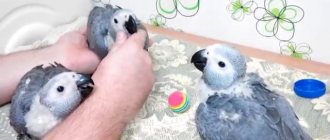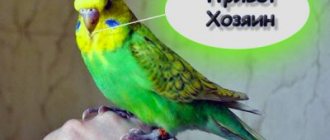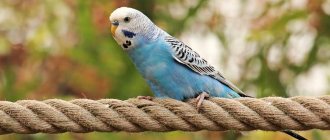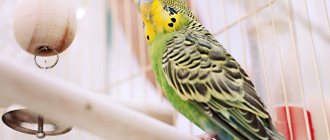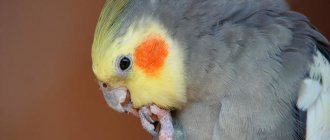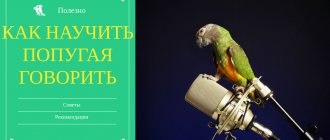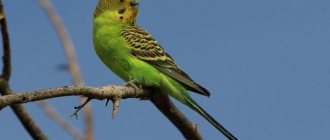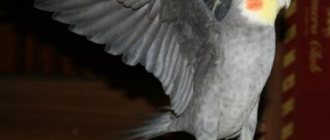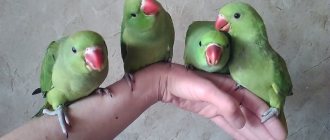A pet always brings a lot of positive emotions, joy and fun. Especially if your feathered companion is a parrot. This is an affectionate, active, sociable bird that takes root well in captivity and becomes very attached to humans. In addition, parrots have another ability that distinguishes their species from all other birds - they can be taught to talk.
Many people, when they decide to have a parrot in their home, count on being able to teach the bird to speak. However, many of them have a very vague idea of not only how to do it correctly, but also do not know which parrots can be taught to speak and which ones - even if you don’t try so hard, the bird will still not be able to greet its owner when he returns home. We decided to fill this information gap and help not only choose the parrot that can be taught to speak, but also tell you how this can be done. However, be prepared for the fact that such training will take hours, or even weeks, and the more systematic and competent your approach to training is, the faster your bird will speak.
What parrots can be taught to speak?
It is a well-known fact that parrots are capable of reproducing human speech. However, birds do not “talk” on their own. In order for your pet to say at least one word, training is necessary. This process is lengthy; it is not easy to teach a bird to pronounce words. Depending on the bird’s abilities and its species, training can take from 3 months to a year, subject to daily regular training. Note that there are birds that are not capable of reproducing words. Let's look at the most popular types of parrots for their learning ability:
- Wavy. Is it possible to teach a budgie to talk? This species is considered one of the most chatty. They begin to “speak” earlier than others, but it is still not possible to quickly teach them human words. The vocabulary of these birds can reach several hundred words, and their pronunciation can be called perfect. There are cases where budgies reproduced poetry. A trusting relationship with your pet will help speed up the learning process. However, for the bird to “speak” it will take not a single day or even a month.
- Corella. This type of parrot does not have special learning abilities. It is quite possible to teach a cockatiel to talk, but the process is more difficult and lengthy than in the case of budgies. In addition, the vocabulary of these birds is less rich and the pronunciation of words is not as clear. A cockatiel can learn no more than 10 words. Only young individuals can be trained. Adult birds are not capable of reproducing words.
If the pet is young, then training should begin with hand training. After the bird ceases to be afraid of people, they begin directly to speech exercises and activities. Corella is a smart pet and can become a “teacher” himself. A “talking” parrot of this species can teach speech to other birds and small children.
- Lovebird. These pets are among the most taciturn when it comes to human speech. At the same time, individual individuals can be trained. A lovebird can learn the pronunciation of 5 words. The learning process will be long; parrots of this species do not learn words quickly. In addition, only young individuals can learn to “speak.” If the lovebird “speaks,” then he will pronounce the words clearly.
- Rosella. This species, like the previous ones, does not differ in speech abilities. Rosella can learn a few words. The bird's vocabulary is limited to the name of the owner and some other word that is directly related to the bird itself. Learning to speak in rosellas is a long process and not always successful. If you expect that your pet will be able to learn a few phrases, then don’t get your hopes up.
- Cockatoo. This bright giant has not only an exotic appearance, but also high learning abilities. The cockatoo is capable of reproducing human speech - words and individual phrases. This feature of the bird allowed him to become one of the most popular participants in circus shows. However, it takes a lot of time to train a pet. It is not possible to quickly teach a cockatoo to speak.
- Jaco. The smartest parrots are grays. Their unprepossessing appearance is more than compensated by the bird's ability to imitate the human voice. According to breeders, the Gray Gray is the most chatty bird among parrots. His vocabulary contains at least a hundred words and short phrases. Thanks to its inquisitive mind, the Gray learns quickly, remembers words for a long time and is able to use them exactly in accordance with the situation.
Selection of words and phrases
You need to choose the right syllables and sounds to teach your parrot to speak. You can also start training with the pet's name. There are no problems with pronouncing the name. As you learn, the task gradually becomes more difficult.
First stage
The easiest way for a bird to recognize its own name. Her pet hears from all family members from the moment he arrives in his new home. To force the parrot to pronounce it, it is necessary to clearly pronounce the name when approaching the cage, while eating, and when the bird is in a good mood.
Important! In addition to the nickname, no other words or phrases should be used; this will confuse the bird and complicate its training.
Basic set of words
If you have managed to teach your parrot to speak syllables and a nickname, you can begin to increase your vocabulary. To do this, a basic set of words or short phrases is determined. These can be cool phrases or basic expressions.
Further training occurs according to the principle:
- A person approaches the cage and says “Hello, Kesha! (parrot's nickname)."
- While treating the bird they say “Kesha eats”, “Kesha drinks”.
- During hygiene procedures: “Kesha is cleaning her beak,” “Kesha wants to take a shower.”
- While the bird is resting, the phrases “Kesha is happy”, “Kesha is happy” are said.
- When a pet is angry or capricious, it’s time to say “Kesha is angry,” “Kesha is angry.”
All phrases are learned one by one. There is no need to say different words all the time, this will only confuse the parrot. The following phrases are pronounced after mastering the previous ones.
Situational conversations
Gray parrots, macaws, cockatoos and other large birds are most prone to talking. You can teach it to a bird if you regularly voice all its actions.
At what age is the best time to adopt a budgie?
Young budgerigars leave the nest at the age of 30 days (deviations in either direction are about 5 days). At first, the chicks fly after their parents, begging them for food, but at the same time, almost from the first day after leaving the nest, most chicks already begin to eat on their own.
The sooner the bird gets to you, the better. The age of 35-40 days is the most promising, but parrots that were separated from their parents at the age of 50 days also began to speak.
You need to choose a strong bird that is already capable of flight. Beware of purchasing a parrot that sits ruffled, with its head hidden under its wing, and sits on the floor of the cage. This chick is either sick or too young and may die in a few days.
All parrots have a so-called cere at the base of the beak - a featherless area on which the nasal openings are located (except for parrots, only owls have a cere).
How to determine the sex of a parrot by wax
The age and sex of budgerigars are distinguished by their cere. In young males who have just left the nest, it is usually convex and pale pink in color. Then the color of the cere changes and at the age of the parrot about three months it becomes light blue, and later it darkens and by five to six months it already becomes bright blue, the same as in completely adult birds.
In young females, the cere is either completely white, or in some cases pale blue, only there are white areas near the nasal openings. It is sometimes difficult to distinguish such birds from young, three-month-old males. However, two to three weeks pass, and in females the blueness disappears completely, the wax becomes white. When the female begins to nest, her cere sometimes turns brown. Pay attention to the coloring of the selected birds. Green parrots quickly begin to imitate human speech. Under natural conditions in Australia, all wavy companions are green. Only through selection did man manage to change their color.
Are there differences in training between males and females?
Boy parrots are considered more trainable than girls. Approximately 9 out of 10 males begin to pronounce words after 3-4 months (with properly structured training). For girls, this statistics is lower - only 6 out of 10 females decide to utter human words after a couple of months.
Training methods for males and females are no different. You just need to be prepared that the feathered ladies’ training lasts 2–3 times longer than that of the “boys.” The reason is that in the wild, males use their voice more often - this is how they drive away rivals and attract ladies. Female parrots are more silent. But if you manage to teach a female to speak, she will pronounce words more clearly than most males.
Video: Confirmation that female budgies talk too
The influence of budgerigar gender on receptivity to learning
It is known that the sex of a parrot plays an important role in its ability to learn to speak.
Males are more susceptible to onomatopoeia than females, and if you absolutely want your parrot to talk quickly, choose a male.
This fact is confirmed by examples of a record vocabulary possessed by males. So the most sociable is the budgerigar Puck, who knew 1770 words. However, this does not mean that girls cannot “speak” at all. The exception is the female Australian parrot.
It is more difficult to teach females to speak, and it will take longer to work with the bird, but females pronounce words clearly, cleanly and loudly. There are also cases when a talking male was placed next to a female, and after a while she also began to repeat some words.
Which parrot is the most talkative?
Many people want to have a feathered pet that can talk, and one question that torments us when choosing is which parrots can be taught to speak? It is best to take a bird of a certain species, that is, one that will be best trained.
The most talkative parrots are:
- Jaco
Birds are very smart, capable of remembering a huge number of words, as well as using and using phrases and sentences in certain situations.
Gray Jaco is not whimsical in his keeping, has a bad character, and likes to occupy dominant positions. It is better to find a common language with a capricious pet and then he will reciprocate.
- Budgerigar
Quite noisy and talkative individuals can easily remember the words you often use, but basically they do not carry any semantic meaning, since these are just words learned by heart.
Their wavy counterparts are easy to care for, they are not whimsical and do not require special attention.
If you decide to have such a talking friend, then it is better to take a young parrot, so it will be easier to teach him to repeat words and phrases.
- Corella
Cockatiels quickly get used to people, are able to remember words, and also parody sounds and melodies. And if you start training the bird closely, you can increase your vocabulary to 250 words.
The bird loves to communicate with people, but taming and training this species is quite a hassle, at least having strong patience certainly won’t hurt.
All these species are considered talkers, but you should not think that if you take one of these birds, it will immediately begin to talk, no, especially since this may not happen. Even among the listed species there are also mute individuals, so do not be too upset if your pet cannot be taught to speak.
Rules for teaching parrots to talk
The process of teaching a parrot to speak is long and laborious. It requires patience from the person who has taken on the role of teacher. According to ornithologists, parrots perceive the speech of women and children better, so the owner of the pet is preferable as a teacher. One person should handle the bird. In addition, the following rules should be taken into account:
- Classes are conducted in complete silence, as parrots are naturally terribly curious. If the silence regime is not observed, the “student” will become distracted and will not remember the required combination of sounds. Particular attention should be paid to the TV. The sounds coming from it will not allow the bird to concentrate.
- Teaching words should be accompanied by corresponding action. When learning the word “hello”, you should enter the room, and “bye” is said if you leave the room.
- Classes should be scheduled at the same time. The duration of the lesson should be 15-20 minutes. In addition, once a week it is recommended to conduct a long strengthening lesson for 40-45 minutes.
- The first word to learn must have two syllables.
- To facilitate training, the use of a tape recorder or voice recorder is allowed. The recording periodically turns on and off, but during the lesson you must be close to the “student”.
- It is necessary to interest the pet and maintain its curiosity throughout the lesson. Signs such as head movements, wing twitching and blinking indicate interest on the part of the ward.
- You can't yell at the bird and punish it. If the student is not in the mood to study, you should give him a treat that will attract his attention.
- One of the rules of learning is persistence. Even if the “student” does not want to study, it is necessary to attract his attention.
- Young parrots should be taught from the age of 2 months.
Important nuances affecting learning
If you're still not sure whether budgies talk, you may simply be missing important information about training them. These tips have an amazing effect, so we advise you to sneak them into your piggy bank:
- Not all birds have the same talent for onomatopoeia, and determining its degree at the purchasing stage is quite difficult. So what kind of budgies talk? Let's put it this way: your chances of teaching your parrot to talk will increase if you choose a bird that is calm, but keen on the world around it, who shows interest in your speech and listens to extraneous sounds.
- It is better to train a bird alone, before other brothers have moved in with him. This way he will hear only your speech, absorbing the words you need.
- The training room must be quiet, otherwise the bird will be distracted by extraneous noises, and the effectiveness of the lesson will greatly decrease.
- Remember that only in an atmosphere of coziness and comfort can a budgie be taught to speak. Don't yell at the bird, show affection, listen to its behavior. If you see that your pet has stopped paying attention, it means that he is bored or tired, and it’s time for you to stop the activity. If your parrot's interest lasts longer than the recommended 15 minutes, take advantage of this situation if time allows.
- Remove toys and a mirror from the cage during the lesson so that the parrot is less distracted. But after training, you must return the mirror, because in the absence of other parrots nearby, your pet will share the new “song” with him, practicing at the same time.
- Change your voice to a higher pitch or let your wife or child do the teaching. For a parrot, this voice timbre is the easiest to reproduce. It is important that, especially in the early stages, lessons are taught by one person - the one who has the strongest contact with the bird.
A quick method for teaching a parrot to talk
For training, choose either young individuals or adult males no older than 4 years. The most difficult words to learn are the first words. A “talking” person will remember words faster. In this regard, in the presence of a pet it is necessary to monitor your speech. To teach a bird to “speak” as quickly as possible, use the following recommendations:
- Choose the right class time. It is recommended to set aside time for lessons in the morning before feeding. However, according to trainers, the quality of training is not affected by what time classes are held. The main thing is that the lessons are regular and the bird stays awake. In addition, during the day you should address your pet several times, as if you were a small child, pronouncing the right words.
- Create a pleasant atmosphere. During classes, it is necessary to maintain a friendly attitude. The “student” should feel comfortable and safe. You cannot raise your voice, wave your arms, or threaten. Classes should be fun. In this regard, it is recommended to sit the bird on your hand during the lesson, but the pet must do this himself. Picking it up and forcibly holding it on your hand is strictly prohibited. The room should be warm and light.
- What words to start with? The training program should include words containing the vowels “a” or “o”; among the consonants, “k”, “p”, “r”, “t” are recommended. Examples of such words are: Roma, dad, Cora, Tom and others. Birds remember words with hissing words well: eat, Kesha, chao, Gosha. It is recommended to take the pet's name as the first word to learn if it contains no more than two syllables.
- Watch your speech. Once the learning process has started, you need to pay attention to your vocabulary. Parrots are attentive students and will imitate even those words that you accidentally used. Avoid using abusive language or profanity in the presence of your pet. Otherwise, the “student” will learn the wrong lesson.
- Learning poems and songs using a tape recorder. As additional training tools, it is recommended to use technical equipment - tape recorder, voice recorder. They use TS to memorize voluminous information. The poem or song is recorded on a tape recorder and audio material is included as needed. In this case, you should be present next to your pet. The use of TS provides the opportunity to repeat educational material many times.
- Praise your pet often during training. The key to the success of classes is the positive attitude of the student. For this reason, during lessons it is necessary to constantly encourage and praise the parrot, regardless of its success. The slightest rudeness or careless movement can cause fear and anxiety in the little “student”. Regaining your pet's trust after this will not be easy.
How to teach an adult budgie to speak
With age, a parrot's susceptibility to learning decreases, and it is more difficult to teach an adult pet to speak. If you still decide to try, then regular exercise for 10-20 minutes several times a day will eventually bear fruit. Birds that are already 2-3 years old may well learn to speak. Although there is a known case when a 10-year-old budgerigar also spoke.
To achieve success, it is important to comply with the following conditions:
- Loneliness. A parrot, who has lived only surrounded by people since his youth, perceives them as his flock and learns to speak their language. It is very difficult to teach a pair of parrots that initially live together to speak at once, since communication with each other is enough for them.
- The bird needs to be tamed. A winged pet, wanting to communicate, will willingly fly into the arms of its owners and listen to their speech. It is strictly prohibited to grab and scare a newly born chick with loud noises.
- Systematicity. Conversation training should be carried out daily, in several sessions of 5-10 minutes, while the parrot is placed on your arm or a cage is placed next to it.
- Consistency. The bird should be taught to speak by the same person, preferably a woman or a child.
- Diversity. After the birdie learns its name, you can teach it several simple phrases at once, because the parrot may simply not want to repeat words it doesn’t like.
- Do not overdo it. If the parrot has flown away, or is starting to get nervous while sitting in a cage, stop, let the bird rest and absorb the information. Treat yourself to something tasty.
Does the ability to speak depend on gender?
All breeders agree that it is much more difficult to teach wavy girls to talk than males.
The owner, who has spent a lot of effort teaching the female to speak, is rewarded with clear pronunciation of words and entire phrases. This is considered a big victory. There are cases when a female taught the correct pronunciation of the words of a male placed next to her.
Conversely, a well-trained boy usually begins to share his skills with a young girlfriend assigned to him.
Interesting! It is much easier to teach a bird to talk if the parrot is alone in a cage. A pair of wavy cats that live together are always busy with each other and it is useless to teach them sound imitation at home.
How long does a budgie remember learned phrases?
Parrots have a very good memory, especially in their youth, and the bird will never forget phrases learned in the first year of life. Although, if you do not periodically repeat the material covered, the clarity of pronunciation will suffer, or the parrot will begin to mix the letters with bird chirping.
Often parrots stop talking when another individual moves in with them, and the couple begins chatting among themselves in their own language. Don’t assume that your pet has forgotten everything in joy.
Usually, such “family” parrots remember the phrases they have learned, they simply limit their use for a while, and there is no need to stop practicing.
Funny phrases from budgies that will cheer you up
A parrot is an entertaining bird in itself, and if it also says something funny or amusing, a good mood is guaranteed. Come up with and teach your pet some phrases that will be interesting to hear for both you and your guests. For example, when it sees its owner in the morning, a bird may shout: “My little bunny, can I give you some coffee?”, or: “Come and give me a kiss!”
You can expand your pet’s repertoire with “winged” sayings from the famous cartoon about Kesha:
“What am I wearing? In rags, like Cinderella!”
“Well, after this rain, expect a good calving”
"Freedom for parrots!"
If there is a cat in the house, you can teach your parrot to scream when he approaches, “get the animal away,” or “let the cat eat.” Some phrases can even be useful, for example, a parrot will remind its owner “Did you turn off the iron?”, “Buy some bread!” or: “Stop eating, watch your figure!”
Taking good care of your budgie, treating it affectionately and regularly exercising it will allow you to soon acquire a true friend. And provided that the pet’s vocabulary is constantly updated, an inquisitive little bird can become a funny and restless interlocutor not only for you, but also for your guests.
Why parrots can talk
The question of why a parrot speaks worries many. The answer is very simple and obvious: chicks reproduce what they hear and what they are taught. Some individuals are able to produce sentences with meaning, this is where you really think about the uniqueness and mystery of the world of these talkers.
The reason why a parrot talks is believed to be its mind. These birds are quite smart, as they can remember and pronounce words.
This is interesting! Scientists commented on the mental perception of talkative birds: “Parrots are very responsive and friendly, and also know how to sympathize with the experiences of their owner, are consistent, can think logically, recognize themselves in the mirror and admire themselves for a very long time.”
Feathered talkers can not only speak, but also reproduce the voices and sounds of animals, for example, cats and dogs. They also imitate sounds, such as the sound of water flowing from a tap, the sound of your phone buttons, and various sounds of household appliances.
In order for your pet to learn to speak, you need to devote a lot of time to your feathered friend. His training should begin as early as possible. The words and phrases that your pet memorized in childhood will never be forgotten. If the bird is deprived of attention, it will most likely grow up to be a savage, and you will hear nothing more than a ringing trill.
